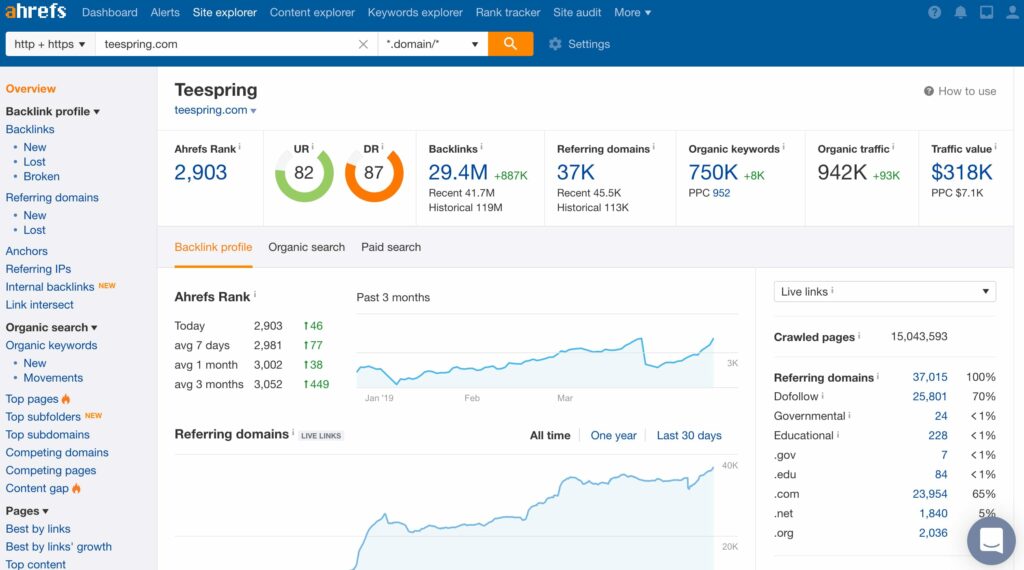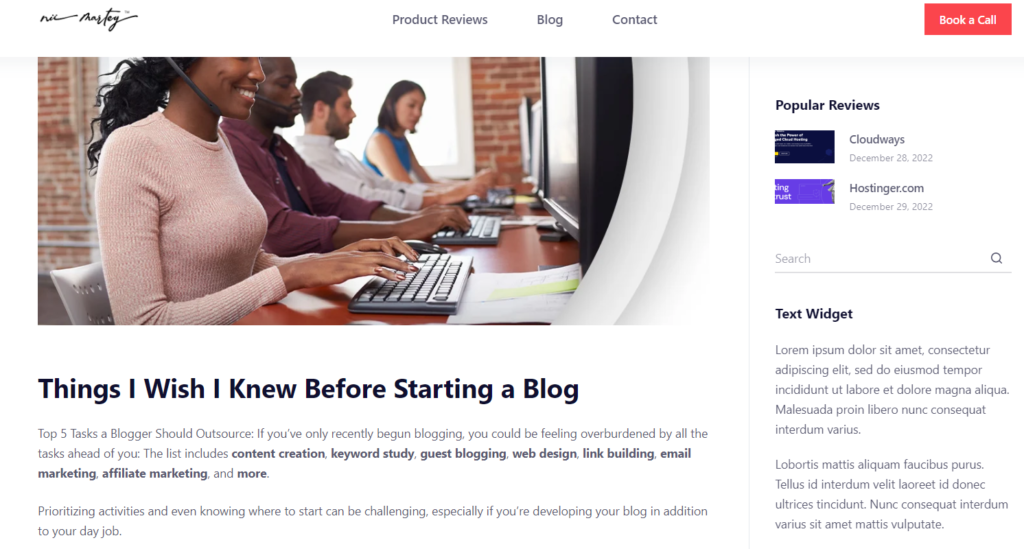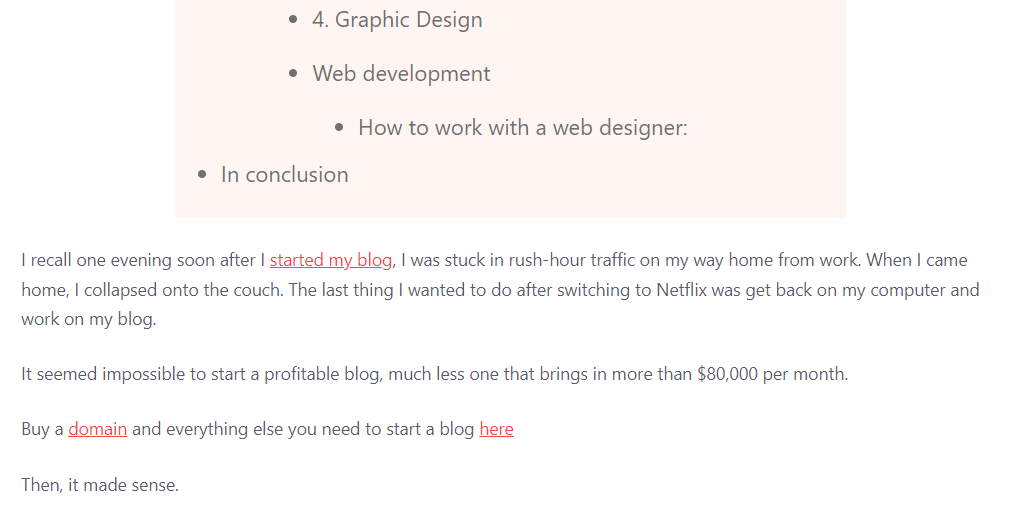How To Maximize Link Building With The Leverage Flywheel Method: This concludes my three-part series on “Scaling Your Influence.” The Keyword Research Matrix explained how, if you want to monetize your blog, transactional purchase intent is necessary and that keyword research is straightforward but sometimes taught improperly.
This series aims to fundamentally alter the way you think about earning money online so you can grow your influence quickly and build a blogging business that allows you to do whatever you want.
Let’s get going.
- Link Building
- How Can You Add Value Through Link Building?
- The Myth of Passive Link Building
- Other Elements in Link Value Determination
- The Domain Rating of the Linking Website
- The linking page’s URL rating
- The Article and Linking Site’s Relevance to Your Niche
- How many external links are present on the linking page
- Where the Link Is Placed in the Linking Article
- The Anchor Text
- Leverage-base Link-Building
- SUMMARY
Link Building
Links are the currency of the Internet. Are you wealthy or broke?
You’ve probably read a ton of articles about different link-building techniques, such as guest blogging, broken link building, link reclamation, unlinked mentions, blog comments, HARO outreach, link partnerships, etc.
These articles usually explain how to conduct outreach, what tools to utilize, and various strategies to begin building links.
However, they are lacking one crucial element.
Leverage
Think about this.

Links are similar to money. Your chances of ranking higher on search engines increase with the amount you have. Additionally, the higher your odds of ranking well in searches, the more money you could possibly make.
Getting a backlink has value just for being a backlink.
And keep in mind that the Domain Rating (DR) of the website from which you are obtaining the link directly affects the link’s worth.
The Ahrefs-created DR metric, which ranges from 0 to 100 and is based on your link profile and ability to rank on search engine results pages, is similar to Moz DA (SERPs).
- Your DR is 0 when you launch a new blog.
- DRs for small blogs range from 30 to 50.
- My DR right now is 78.
- Significant blogs have DRs between 70 and 80.
- There are DRs in the 80s and 90s for big SaaS companies.
- Popular websites like Google, YouTube, and Facebook have DRs of 99 or higher
How does this translate to value, then?
Well, a high-quality link from The New York Times or Wikipedia with a DR of 90+ is considerably more valuable than a link from a small, specialized blog with a DR of 25.
- You Might Like: The easiest way to live stream and record

The linked website passes link value on to your website. In other words, a site connecting to you is more useful if its DR is higher.
In Google’s eyes, these new links represent endorsements. They demonstrate the reliability of your blog.
Because they are challenging to obtain, backlinks continue to be one of the main criteria in Google ranking. You have to work for them; they don’t just come.
They are also valuable.
Consider this.
For a single high DR link, I’ve seen digital marketing companies charge anything from $500 to $3,000.
These priceless links have a genuine market influence if obtaining a few high DR backlinks can assist you in rising to the top of Google and earning money from your post afterwards.
Why would a website provide you with this value for nothing in exchange?
It is not logical.
Even if you create the most amazing, link-worthy piece and execute the optimal outreach to request the ideal link placement, you could still fall short.
Why?
The other person receives nothing from it that is worthwhile.
In the end, you’re asking someone to work on your behalf (add a link to their website) for your own gain and with no value to them.
What do you then?
Exert influence and add value

You exert influence and add value
You establish a genuine, win-win partnership.
I like to refer to this as leverage-based link building, and I came up with it in the year 2020.
In the first two years of my blog’s existence, I used leverage-based link building to raise my Ahrefs Domain Rating from 0 to 78 and acquire links from 433 DR 70+ websites. 44 of these 433 sites had DRs of greater than 90.
These websites, including Forbes, Business Insider, Entrepreneur, WP Engine, GoDaddy, Weebly, Yahoo!, HubSpot, BigCommerce, and others, are among the most authoritative on the Internet.
Google started to treat my backlinks from all of these websites seriously. They helped me expand my blog’s traffic from nothing to 500,000 monthly visitors and to over $80k in monthly revenue.
Although I don’t want to boast, I do think I’m among the top link builders in the world.
How did I manage it?
- Hosting makes easy with Hostinger, Try it Now
Utilization-based connection building

This is not a low-quality or unethical link-building strategy. It is white hat link building on steroids, yet few businesses or SEOs are aware of it. The world is a marketplace of values.
The Phoenicians are credited with starting bartering over 8,000 years ago by exchanging their goods for food, weapons, and spices potential.
Everything was made simple: produce an excess and exchange it for scarcity.
Due to this, farmers were able to feed not only their families but also the entire community. Anything they couldn’t obtain themselves, such as spices, weapons, or fabrics, could be exchanged for their surplus crops.
The same rules still hold true in today’s value exchange-based capitalism system:
- You work all day at a corporate job, then you come home and make an Amazon buy. You exchange your wealth (money) for a good you can’t make yourself (scarcity).
- On Craigslist and Facebook Marketplace, you exchange things.
- By investing in the stock market, you can purchase stock in a firm today for a potential return tomorrow.
- In order to win favor with your wife, you could even cut your in-laws’ yard or bring them dinner (but are you really doing it out of the goodness of your heart?).
Nearly every human being engages in bartering.
We prefer safety and abundance over risk and shortage. We exchange what we have in large quantities for what is in short supply.
It’s self-serving, but we frequently inquire about:
Why should I care?
When it comes to link building and expanding a successful blog, this strategy of bartering and exchanging value for value is exactly the same.
Partnerships cannot involve a one-way transaction.
You must look for opportunities to add value.
- StreamYard: The easiest way to live stream and record, Try us for Free Now
How Can You Add Value Through Link Building?
You can exchange valuable items in the digital realm, just like you can in the actual world. You must first comprehend what is genuinely useful in the digital world in order to accomplish this.
What then is valuable?
According to my work with e-commerce brands, agencies, SaaS businesses, and bloggers, everyone wants one thing:
Links.
You must be able to offer quality links in exchange if you want to establish an internet partnership and receive backlinks for your website.
It’s that easy.
It’s a value exchange, not a one-sided offer, to reiterate
Another option is for a blog to provide the lure of “add this link to your blog and I’ll share your post on social media” as if disseminating a piece to a small number of their followers were equivalent to having my blog link to it highly.
You Might Like: Top 5 Tasks a Blogger Should Outsource (and How to Do It)
It’s not; these emails are simply thrown away. What’s in it for me, once more?

What is a connection worth then?
Most likely more than you imagine.
Link value estimation is not a precise science. It depends on a number of variables, including the Domain Rating of the website, its niche, traffic, brand equity, etc.
In all areas, if I were to estimate something utterly unscientific, I would guess that one dofollow backlink is worth:
- DR 0-20: $50
- DR 21-40: $100
- DR 40-60: $200
- DR 61-70: $400
- DR 71-80: $500
- DR 81-90: $600
- DR 90+: $1,000
Ahrefs also conducted research on the worth of backlinks and discovered that the typical cost of acquiring a link was $352.92.
With the help of this framework, you may start to comprehend the worth of links, which will make trading them easier and increase the value you receive.
The Myth of Passive Link Building
The holy grail of link development, according to many search engine optimization specialists and content marketers, is “passive link building”—getting links to an article without doing anything since your post is so excellent.
Making original research, including infographics, videos, case studies, and authoring high-quality content are all ways to use this link-building strategy.
While some of your guest posts should include all of the aforementioned components, passive link building is largely a fiction.
The adage “Build it and they will come” is invalid in 2021. Obtaining high-quality links is a process that only benefits the most well-known websites.
Take the case when you write a fantastic post with tons of original research, infographics, and videos. It is significantly superior to anything appearing on Google’s first page.
A new article you write won’t, however, immediately begin to rank. It might not even make the top 100 results; it might be on page 4, page 5, or something else entirely.
Who will discover it?
The vicious cycle of passive link creation is built on visibility; because they are more accessible, sites that are already ranked receive more links.
Cloudways removes the complexity of cloud hosting and lets you focus on what
matters most: your business!. Try it for free

Consider this.
When a blog or news site needs a resource, they Google it, swiftly locate the solution based on one of the articles with the highest search engine rankings, and link to it.
The best sites get rewarded.
For well-known, highly visible websites, passive link development can be effective, but for new bloggers, it is practically impossible.
Conclusion: Many new bloggers are discouraged by the notion of passive link building.
What do you then?
No one else is going to grow your Domain Authority for you, so you need to get moving and do it yourself.
Other Elements in Link Value Determination
Keep in mind that not every link is made equal. Before you begin link building, there are a few tricky small aspects that you should be aware of.
We already know that a backlink is an anchor text link that directs readers to your website.
How can one site send along its “link juice” to another?
There are many things to think about, but these are the main seven.
Dofollow or Nofollow
There are two types of links from other websites: “dofollow” and “nofollow.”
All links are dofollow unless otherwise specified. When a link is marked as “dofollow,” Google search crawlers “follow” it to the external page and pass SEO value through it.
Links marked as “nofollow” instruct Google not to pass any SEO value and not to “follow” the link to the external website. The “nofollow” HTML element can be manually applied to backlinks, and it is frequently used in the improper manner.
Affiliate links and sponsored links with a promotional bent should be designated nofollow when used properly. A statistic, picture, or useful resource should typically be dofollowed when it is cited.
Blogs frequently attempt to “preserve” link equity by designating an excessive number of external links as nofollow. The reasoning behind this is that if they designate all internal links to their own posts as dofollow and all external links as nofollow, their blog posts would receive greater authority and link juice.
This is not entirely accurate.
When it comes to dofollow/nofollow links and how they convey value, there are several murky areas.
In a case study that they really completed, SEMRush discovered that nofollow backlinks do have some SEO value.
In general, understanding the distinctions between the two categories of linkages is crucial. In general, strive for dofollow links, but be aware that there may also be SEO benefit in nofollow connections.
It’s crucial that you have a healthy balance of the two.
The Domain Rating of the Linking Website
A link from a website with a high DR is more valuable than a link from a website with a lower DR.
This is true almost often, with the exception of a few situations where there is a lower DR site with a disproportionately small number of external links.
If your external connection is one of fewer overall external links, a link from a lower DR site may therefore be marginally more beneficial.
The linking page’s URL rating
Ahrefs offers another statistic that is critical in link development, much as Domain Rating (DR) is the authority of an entire website. The URL of the page is that.

Similar to DR, URL Rating measures the authority of a specific web page rather than a whole website.
A new blog post’s URL rating is normally 10 when it is published. As you establish additional links to this specific post, this figure increases over time.
URL Ratings of 30 and 40 are regarded as high, although Domain Ratings of 70 and 80 are. Usually, URL ratings are lower than domain ratings.
A link from a page with a URL Rating of 20 is therefore more useful in this case than a link from a page with a URL Rating of 10.
The Article and Linking Site’s Relevance to Your Niche
You will frequently gain more from a backlink from a site associated with your niche than from one from a completely unrelated site.
A backlink from Mailchimp, for instance, would be far more beneficial than a link from a random marketing blog if you created a blog article similar to my piece on email marketing software.
How many external links are present on the linking page
One page passes link authority to another. It also depends how many links are on the page.
You would receive about 10% of the link equity, for instance, if you received a backlink from a piece of content that had nine other links (for a total of ten links) on the page.
You receive about 20% of the link equity if there are five links on the page.
Where the Link Is Placed in the Linking Article
Higher on the page external links pass more link equity than those further down.
For instance, a link from an article that appears in the opening paragraph is typically more value than one that is near the bottom.
This is another reason why you should place your own links higher in guest posts, as a link to your home page in your author bio isn’t nearly as useful.

- Join With 1 Million+ Happy Users & Improve Page Building Experience
The Anchor Text
Another aspect of link building is the anchor text, sometimes referred to as the actual hyperlinked words that link to your website.
However, it is losing significance as Google’s algorithm and PageRank become more intelligent and can comprehend the surrounding phrases around the anchor text.
Your inbound links must appear as natural as is humanly possible.
For instance, you wouldn’t want the anchor text for a link to your blog article on “how to make money online” to say “how to make money online.”
It ought to be a combination of one of the following five kinds of anchor text:
- Exactly matching anchor text is known as an exact match (how to make money online). Since they are unnatural and wouldn’t happen frequently without your help, you don’t want many of these.
- Anchor text that only partially matches your target term is a partial match (i.e., ways to make money). Due to the fact that it sounds more natural than an exact match, this type of anchor text is effective.
- Anchor text that is non-matching to your keyword is referred to as this (i.e., in this article). These are the most aesthetically pleasing anchor texts, thus I tend to utilize them rather frequently.
- Branded: Anchor text that matches your company’s identity (i.e., Adam Enfroy). These are beneficial to use because they will inevitably boost brand authority.
- Branded + Keyword – Anchor text that contains both your brand name and the keyword you want to rank for (e.g., Adam Enfroy’s internet business guide). This style of anchor text is particularly beneficial because it links your company name to your intended keyword.
In conclusion, each of the aforementioned elements affects the worth of a certain backlink. They are listed in my personal order of importance, and all should be taken into account if you want to fully comprehend link building.
In conclusion, the ideal connection would be:
A dofollow link with natural anchor text from a high DR niche-related website on a page with a high URL Rating that is prominently placed within the article.
Confused? Don’t stress yourself out too much. Before you begin link building and guest posting, these are just a few things to keep in mind.
Let’s move on to some strategies now that we’ve covered some of the fundamentals.
Utilization-Based Link Building Techniques
Here are a few fresh, leverage-based link-building tactics I’ve started implementing for my blog.
- We make secure cloud storage simple and convenient. Create a free MEGA account today.
Leverage-base Link-Building
Link trading in guest posts
One of the main ways for bloggers to obtain backlinks is by guest posting. The benefit of guest blogging is increasing your Domain Rating so that your content may rank, not generating referral visitors.
Reaching out to other sites in your niche, writing a guest post for them, and linking back to your own blog are all steps in this process.
Writing guest posts for links alone, however, is insufficient. Links from guest posts are also rather unnatural; if Google notices that every single backlink you receive comes from a piece you created for a guest blog, it can trigger an alert.
They might believe that there aren’t enough “natural” mentions of your blog in other articles because you’re the only one connecting to it. When developing your backlink profile, avoid sounding forced.
Therefore, how can you advance guest blogging?
Your guest posts serve as a resource that you employ to build more backlinks.
Take this blog as an example.
I wrote 12 guest posts for various websites in my niche in November 2020.

How did I make these guest posts’ links more effective?
I also included a few internal links for the blog I was writing for as well as some useful data.
However, why end there? What if there were space for further links?
Why wouldn’t I add a few more and utilize that influence to power more links for my own blog if a link is worth $352 on average?
Guest post link exchange can help with this.
The process is as follows: You identify other bloggers in your niche who are submitting guest posts to reputable websites, and you exchange hyperlinks with them in between your guest articles.
Since you already have space to include a few more links, you include theirs in your guest articles and they include yours in theirs.
It’s a win-win.
You can use your guest articles as trade bait and obtain backlinks from other authors’ guest posts through partnerships rather than creating 12 guest posts and requesting links from 12 websites.
You don’t want to overdo it, though, as they should be high-quality links based on genuine connections. There are many practices that, according to Google’s Webmaster Guidelines, are consistence.
The good news ? Once you begin performing a lot of guest post outreach, doing this is not too difficult. As you get to know other bloggers in your niche, these collaborations just happen.
Value Exchange: You provide another blogger links in exchange for them giving you links.
Outreach for guest posts with pre-linking
Before you ever approach a prominent blogger or influencer in your niche, you can offer them a ton of value simply connecting to them in your guest posts.
This will enable you to highlight the worthwhile backlinks you have previously supplied them in your email outreach for guest posts.
I really wanted to collaborate with Pat Flynn of Smart Passive Income, for instance. So I made sure to send him 10 backlinks from some of my guest pieces before contacting him to do a podcast interview.
This pre-linking tactic was successful.
The podcast interview was recorded, his team recognized the importance of the backlinks I offered, and I received a few links from the page for the podcast episode:

This is a difficult to scale method that is very next-level. Once you’ve written a good number of guest articles and are looking for opportunities on websites that might not ordinarily respond to you, I’d try to use it.
Value Exchange: You provide connections up front in exchange for future, high-quality links of equal quality.
Other Methods
I can’t go over each and every leverage-based link-building strategy I employ to increase traffic and generate more than $70,000 a month in affiliate revenue.
It would even be foolish of me to offer this material online for free. I just cannot afford to divulge these strategies to my rivals.
However, I will go into great detail about each one in my online course, which I will be releasing at the beginning of 2021.
SUMMARY
Links are an exchange of value based on leverage.
Less emphasis is placed on a specific link-building strategy and more on the value you can deliver.
Even the best link development tactics can fail if you aren’t adding value.
Focus on showcasing value and providing links rather than creating guest post outreach letters with the intention of obtaining links.
Focus on creating a genuine, win-win alliance rather than obsessing over the ideal strategy, such as broken link building or link reclamation.
A snowball effect occurs as your authority in link building increases
You rank better the more links you have.
- The more traffic you receive, the better you rank.
- More passive links appear when your website receives more visitors.
Additionally, you must begin someplace.
If you’re just starting out with link building, you need to work hard, develop relationships, secure guest posts, amass a surplus of links, and then use that excess to exchange value online.
What do you think of this novel approach to link building using leverage? Have you got any queries about link building?
Let me know in the comments below.
Disclosure: I may receive affiliate compensation for some of the links below at no cost to you if you decide to purchase a paid plan. You can read our affiliate disclosure in our privacy & policy. This site is not intending to provide financial advice. This is for entertainment only.








